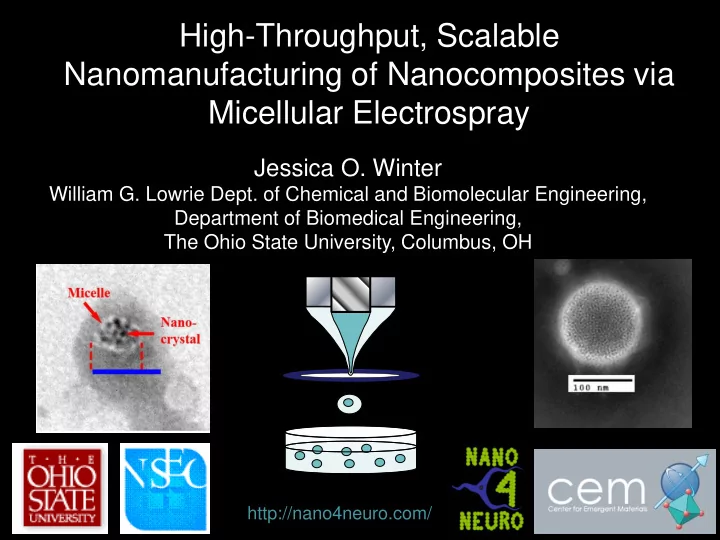

High-Throughput, Scalable Nanomanufacturing of Nanocomposites via Micellular Electrospray Jessica O. Winter William G. Lowrie Dept. of Chemical and Biomolecular Engineering, Department of Biomedical Engineering, The Ohio State University, Columbus, OH http://nano4neuro.com/
Nanocomposite Particles Quantum Dots Magnetic Nanoparticles Broad Excitation Reduce T2 relaxation Narrow Emission (MRI) Bandwidths Biocompatible Low photobleaching Biodegradable High Quantum Yield Exert force in magnetic field Core-Shell Interfacial Doping Gu et al., JACS, 2004, 5664 Deng et al., Nanotech., 2010, 145605.
Self-Assembled Micellar Nanocomposites Ruan et al., Nano Letters, 2010, 2220; Ruan et al. J Nanoeng Nanosys, 2010, 81 Ruan, Winter, Nano Letters. 2011, 941.
Interfacial Instability 1 batch ~ 0.1 mg Zhu JT, Hayward RC. Journal of the American Chemical Society. 2008;130:7496-502. Granek R, Ball RC, Cates ME. Journal De Physique Ii. 1993;3:829-49. Animation by A. Duong
Introduction to Electrospray Collaboration with Barbara Wyslouzil, ChBE, OSU Organic Solvent, Aqueous Solution: Polymer, Water, Surfactant Nanoparticles High Positive Voltage Applied Ground Collection Dish (Water) Manuscript in Preparation
Process Optimization Q=3, Q o /Q i =14 40 C 70 Spheres Mix Worms & Spheres 60 Not Viable Collection Temperature ( C) Spheres Batch 2 50 Mix Worms & Spheres Batch 2 30 C 40 30 20 2 mg/ml 5 mg/ml 10 mg/ml 10 0 10 20 30 40 50 60 PS-PEO Concentration in Organic (mg/ml) Q=3.5, Q o /Q i =2.5
Wormlike Micelles Worms with QDs concentrated in globular regions Spherical micelles
Yield and Size Distribution 30 fold increase in yield 15% size distribution
Particles Produced and Uses Imaging MultiDot: QDs 25 nm Separations MagDot: Magnetic QDs 50 nm Drug Delivery PolyDot: Polymer NPs
Conclusions • Micellar nanocomposites can be synthesized by interfacial instability. • Nanocomposites can be synthesized by electrospray increasing yield and with potential for continuous fabrication. • Synthesis is robust, with little change in particles produced over a wide range of process parameters. • Alternative structures can be created by altering polymer characteristics. • Several types of particles can be produced using this approach. • Particles have applications in several fields.
The Winter Group Collaborators: Jeff Chalmers (ChBE, OSU), Barbara Wyslouzil (ChBE, OSU), R. Sooryakumar (Physics, OSU), Maryam Lustberg (Med. Oncol., OSU), George Bachand (Sandia), Peter Kner (University of Georgia) Funding NSF Awards: CBET-0854015 , CMMI-0900377, CBET-0707969, MCB-1052623, EEC-0914790 (NSEC), DMR-0820414 (MRSEC), CMMI-1344567 NIH: 1RC2AG036559 – 01 DOE: Center for Integrated Nanotechnologies (CINT) The Ohio State University: Institute for Materials Research, Department of Chemical and Biomolecular Engineering, Women in Philanthropy, H.C. “Slip” Slider Professorship
The Winter Lab at Imaging Nano-toolbox Manipulation Biomimetics Drug Delivery http://nano4neuro.com
Recommend
More recommend